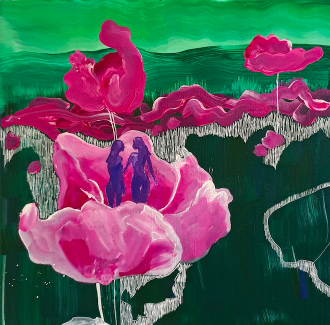


Abstraction has continually remained an iconic trend in contemporary and recent art. For more than a century, artists have been keen to abandon the clear theme and realism of representation in favour of creative expression through, above all, colour and composition. In doing so, the artists deprive the audience of a clear and unanimous interpretation of the work. The result is speculation, subjective explanations or attempts to understand the smallest details of the work. The lack of realistic attribution in a painting can be frustrating, but it is the abstractness that allows us to appreciate the aesthetic qualities of the artwork, such as colour, form, or texture. Abstract works represent a broad spectrum of artistic forms and styles, which is why they are very popular on the art market and easily attract the attention of collectors.
When selecting a work of art for our interior, we should be guided by our own sense of aesthetics, the character of the designated space and the desired end result. Depending on the qualities we are looking for, we can opt for a painting that enlivens the room with its intense colours and dynamism, or on the contrary, tone down the interior with a calm and gentle accent. In either case, abstract works tend to fulfil our intentions for a given space. Because of their unspoken message and clearly emphasized visual qualities, abstract works remain among the more commonly chosen works for interior design.
The thematic versatility makes abstract paintings suitable for almost any interior. It doesn't matter whether one is looking for a work for a private bedroom or a public office. The conformist nature of abstraction will fit into the specifics of any space. As a result, during the process of selecting works of art, we can focus fully on aesthetic qualities and leave interpretative issues to subjective considerations.
It is also worth considering what a painting can do for a given space. Apart from the purely decorative aspect, a work of art can clearly emphasize selected characteristics of a place, as well as hide its imperfections. The very presence of art in an interior increases the prestige of the surroundings, and additionally, the specificity of the representation can help to achieve specific spatial effects. By hanging a dynamic painting with intense colours and a distinctive composition, we introduce a single, clear point of reference that draws the eye to a specific area. On the other hand, a work with a lighter character, light colours and clear composition will open up the space and optically enlarge it, but will not dominate the entire room.
In the catalogue of the upcoming Talents auction, we offer a dozen interesting abstract works of recent art. Among them are paintings intense in colour and dynamism, such as Ida Pozarzycka's 'Rhythm of Shadows' (item 13.) or Milena Kopczyńska's 'Scoria no. 2" (lot 90.). The strong stylistics of both works is striking from afar, but the attributive detail in the case of Pozarzycka and the specificity of the canvas texture in the case of Kopczyńska encourage the viewer to have a closer look at the paintings. Those who prefer a calmer, pastel tonality should pay attention to Agnieszka Płaczek's work My Heavens (lot 22.) and Anna Wysocka's To the Test (lot 86.). These are compositions in bright colours, minimalist in character and with a calm disposition, which will certainly add light to the space in question. But let us not forget that abstraction can do even more, as the paintings painted by Fran Wasi (lots 82. and 83.) prove. The canvases attract with their intense colours, but do not dominate with the intensity of the form.
Choose abstraction!
Works of abstract art perfectly modify a space and are great decorations for public interiors. Due to their interpretative versatility, they adapt to their audience and allow contact with art on a purely aesthetic basis. When looking for an abstract painting for an interior, it is worth remembering that, above all, it should suit its everyday companions who will be looking at it.